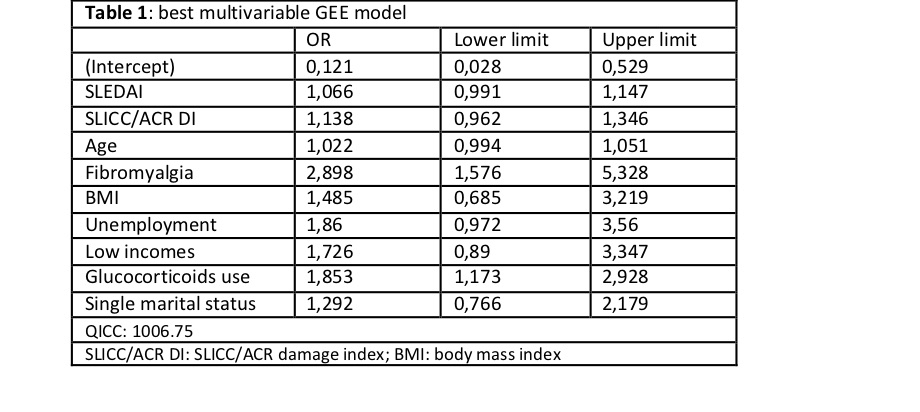Session Information
Date: Monday, November 13, 2023
Title: (1442–1487) SLE – Diagnosis, Manifestations, & Outcomes Poster II
Session Type: Poster Session B
Session Time: 9:00AM-11:00AM
Background/Purpose: The prevalence of depression and associated factors in systemic lupus erythematosus (SLE) are not well known and there are no longitudinal studies addressing this relevant subject in SLE.We aimed to evaluate the prevalence of self-perceived depression in patients with SLE and associated factors in a large, multicenter cohort (RELESSER-PROS).
Methods: Prospective longitudinal study. Patients with SLE (1997 ACR criteria) answering positively to the depression question of the Lupus Impact Tracker (LIT) questionary (LITQ7), over 4 years of follow-up (5 annual visits, V1 to V5). Self-perceived depression was addressed as “depression any time” or “depression most of time”, according to the kind of answer to the LITQ7 (answers 1,2,3 or 4 and answers 3 or 4 respectively). Only patients with no missing values in the covariates, were included in the multivariable analysis. The following covariates were considered: SLEDAI, age, duration of the disease, SLICC/AR DI (SDI), fibromyalgia, Charlson index, smoking, BMI, menopause, sedentary lifestyle, marital status, unemployment and glucocorticoid (GC) use. Friedman test was used to test if the change in repeated measures. Generalized estimating equation (GEE) models with binomial response, were built exploring the associations of individual longitudinal determinants with longitudinal assessment of depression. The best model was selected using quasi-likelihood under the independence model information criterion
Results: A total of 1463 were included. Mean age: 55 (DS±13) years, 90% were female. Mean duration of the disease: 14 (±8.59) years. Fibromyalgia was present in 5.7% (76/1343). Corticosteroids use ranged from 49.4% to 57%, depending on the visit. Median SLEDAI ranged from 0 to 2 and SDI ranged from 1 to 2.
Prevalence of “depression any time” was 89.9% (1104/1228) and 34.6% (200/578) were in depression “most of time”. Up to 26.5% (153/578) answered to LITQ7 “depression most of time” in the five visits; 89.7% of the patients which perceived themselves as depressed at least in 2 out of 5 visits. Only 6.9% of the patients with previous diagnosis of depression answered “0” to the Q7 of LIT (“none of the time”).
Patients with “depression any time” develop more damage at V5 than patients without depression (answer to LITQ7=0) (p = 0.00931, T-test). In the GEE binomial analysis considering all the predefined covariates, that included only patients with no missing values for any of them (namely, 155 patients), fibromyalgia (OR 2.79; 95%CI: 1.28-6.05), unemployment (OR 1.95; 95%CI 1.02 -3.73), and GC use (OR 1.88; 95%CI 1.18-2.99) were significant associated with “depression any time”.
The best model (according QIC) displayed a statistically significant association only with fibromyalgia (OR 2.90; 95%CI: 1.58-5.33) and GC (OR 1.85; 95%CI 1.17-2.93). (Table 1). Without entering glucocorticoids, SLEDAI turns significant in the model, suggesting collinearity.
Conclusion: The prevalence of self-perceived depression is high in SLE. Longitudinal data analysis suggests a causal relationship between glucocorticoids use, fibromyalgia and self-perceived depression.
To cite this abstract in AMA style:
Rúa-Figueroa I, MARTINEZ BARRIO J, Jiménez N, Galindo-Izquierdo M, Uriarte Isacelaya E, Fernandez-Nebro A, Calvo- Alén J, MANRIQUE S, Rosas J, Caño-Alameda R, Narvaez J, Ros I, Aurrecoechea Aguinaga E, Torrente-Segarra V, Sanguesa Gomez C, Freire González M, Tomero Muriel E, Horcada L, Moriano Morales C, Moreno M, Iñíguez C, Blanco R, Pérez Gómez A, Andreu-Sánchez J, Garrote Corral S, Muñoz S, Bonilla G, Lozano Rivas N, Montilla-Morales C, Ibarguengoitia-Barrena O, Expósito L, Valls-Pascual E, Pecondon-Español A, Machin S, Salgado-Pérez E, Erausquin C, SALMAN MONTE T, Menor-Almagro R, Muñoz A, Altabas Gonzalez I, Fragio J, Pego-Reigosa J. Glucocorticoids Use Is a Major Driver of Self-perceived Depression in Systemic Lupus Erythematosus: Insights from a Large, Prospective and Multicenter Study Using RELESSERPROS Register’s Database [abstract]. Arthritis Rheumatol. 2023; 75 (suppl 9). https://acrabstracts.org/abstract/glucocorticoids-use-is-a-major-driver-of-self-perceived-depression-in-systemic-lupus-erythematosus-insights-from-a-large-prospective-and-multicenter-study-using-relesserpros-registers-database/. Accessed .« Back to ACR Convergence 2023
ACR Meeting Abstracts - https://acrabstracts.org/abstract/glucocorticoids-use-is-a-major-driver-of-self-perceived-depression-in-systemic-lupus-erythematosus-insights-from-a-large-prospective-and-multicenter-study-using-relesserpros-registers-database/

